
Saab AB, with subsidiaries collectively known as the Saab Group, is a Swedish aerospace and defense company primarily operating from Sweden. The company is headquartered in Stockholm, but its development and manufacturing operations are undertaken in Linköping.

The Saab 37 Viggen is a single-seat, single-engine multirole combat aircraft designed and produced by the Swedish aircraft manufacturer Saab. It was the first canard-equipped aircraft to be produced in quantity and the first to carry an airborne digital central computer with integrated circuits for its avionics, arguably making it the most modern/advanced combat aircraft in Europe at the time of introduction. The digital central computer was the first of its kind in the world, automating and taking over tasks previously requiring a navigator/copilot, facilitating handling in tactical situations where, among other things, high speeds and short decision times determined whether attacks would be successful or not, a system not surpassed until the introduction of the Panavia Tornado into operational service in 1981.
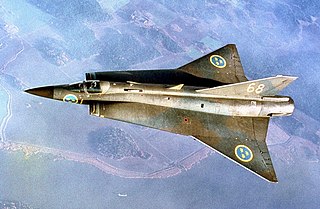
The Saab 35 Draken ) is a Swedish fighter-interceptor developed and manufactured by Svenska Aeroplan Aktiebolaget (SAAB) between 1955 and 1974. Development of the Saab 35 Draken started in 1948 as the Swedish air force future replacement for the then also in development Saab 29 Tunnan dayfighter and Saab 32B Lansen night fighter. It featured an innovative but unproven double delta wing, which led to the creation of a sub-scale test aircraft, the Saab 210, which was produced and flown to test this previously-unexplored aerodynamic feature. The full-scale production version entered service with frontline squadrons of the Swedish Air Force on 8 March 1960. It was produced in several variants and types, most commonly as a fighter-interceptor.
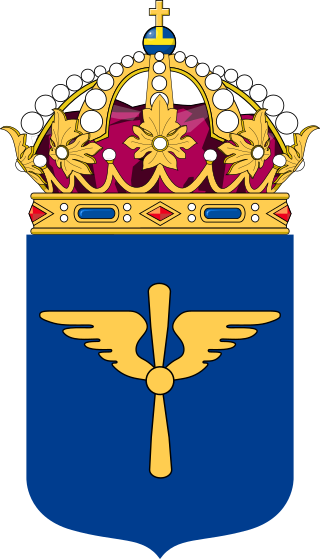
The Swedish Air Force is the air force branch of the Swedish Armed Forces.
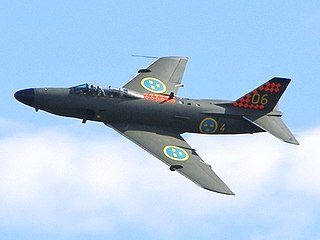
The Saab 32 Lansen is a two-seat, transonic military aircraft designed and manufactured by the Swedish aircraft manufacturer Saab AB.

Volvo Aero was a Swedish aircraft, guided missiles and rocket engine manufacturer. It became GKN Aerospace Engine Systems following the company's acquisition by British engineering conglomerate GKN during 2012.

The Rolls-Royce Avon was the first axial flow jet engine designed and produced by Rolls-Royce. Introduced in 1950, the engine went on to become one of their most successful post-World War II engine designs. It was used in a wide variety of aircraft, both military and civilian, as well as versions for stationary and maritime power.

In aerobatics, the cobra maneuver, also called dynamic deceleration, among other names, is a dramatic and demanding maneuver in which an airplane flying at a moderate speed abruptly raises its nose momentarily to a vertical and slightly past vertical attitude, causing an extremely high angle of attack and momentarily stalling the plane, making a full-body air brake before dropping back to normal position, during which the aircraft does not change effective altitude.
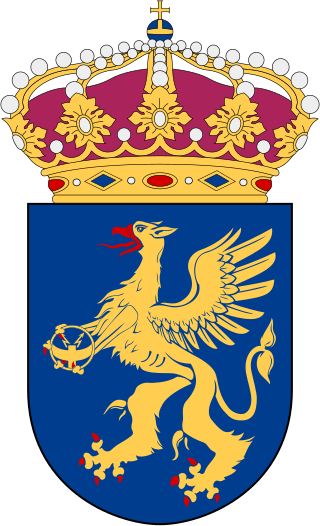
[Swedish] Tactical and Air Defence Control System in forms of STRIL 50 and STRIL 60 were integrated systems for aerial warfare control including early warning radar and ground-controlled interception. The systems depended on radar and radio as primary technologies but STRIL 50 was based on manual control while STRIL 60 applied the usage of early digital computers.

The Saab RB05, initially named Saab 305 or AT 3 internally, was a short-range air-to-surface missile with limited air-to-air capability that was developed in the 1960s by the Swedish company Saab-Scania, Missiles and Electronics for the Swedish Air Force.
This is a list of weapons used by the Swedish Air Force.
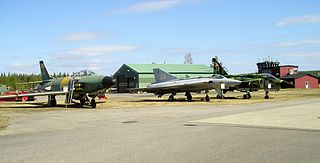
Vidsel Air Base is a Swedish Air Force airfield located 15 km west-northwest of the town of Vidsel, in Sweden. It is a critical part of Vidsel Test Range that provides an aerospace test and evaluation asset for Sweden through the Test & Evaluation (T&E) department of Swedish Defence Materiel Administration (FMV).

The Estonian Aviation Museum is located in Lange near Tartu in Estonia. It is the only aviation museum in the country.

Otto Hermann Bernhard Behrbohm, born 30 October 1907 in Karlsruhe, Grand Duchy of Baden, Imperial Germany; died 12 October 1977 in Fingelsham, Northbourne, Kent, United Kingdom, was a German mathematician active in Sweden and Germany.

Bertil Dillner was a Swedish aeronautical engineer and aerodynamic expert. He was significant in the development of delta wing aerodynamics and supersonic flight concepts. Dillner served for many years as manager of Boeing engineering design offices.

Erik Gustaf Bratt was a Swedish engineer and pilot. Erik Bratt was the brother of Colonel Lars Bratt.
Tore Ragnar Gullstrand, born 16 August 1921 in Karlstad, died 2002 in Linköping, was a Swedish business leader in the aviation industry and researcher in aeronautics. He was the son of Ragnar Gullstrand.
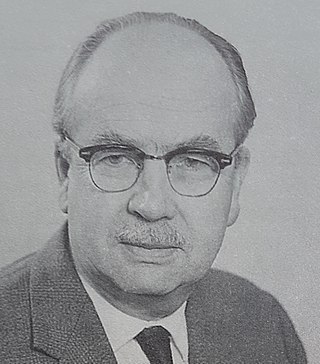
Frid Benjamin Filippus Wänström was a Swedish aviation engineer who after KTH Royal Institute of Technology in 1932 was employed by the flygstyrelsen, from 1936 head of the calculation department Saab AB in Linköping.
Lieutenant General Kjell Gustav Nilsson was a Swedish Air Force officer, ice hockey player and sports administrator. Nilsson's senior commands includes commander of the Northern Air Command (1995–1996), Chief of Staff of the Northern Military District (1996–1998), and Chief of Joint Operations Command (1998–2000). Nilsson served as chairman of the Swedish Ice Hockey Association from June 2002 to June 2004.



















